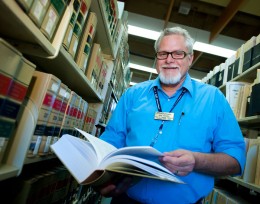
Ran Raider and Wright State's Patent Trademark Resource Center offer workshops and individual counseling to help inventors file the appropriate paperwork.
Google started in a garage. So did Apple and Motorola. The genius of independent inventors touches our lives a million ways each day, but soon the way inventors secure their patents is going to change.
Next March, for the first time since our nation was founded, the United States will become a ‘first inventor to file’ country, reversing its stance of over 200 years of operating as a ‘first to invent’ country.
What does this mean? Individuals, companies and universities will now only be able to lay claim to inventions after they have been patented. They will no longer be able to dispute patents simply because they have proof they came up with the idea first.
“Both trademarks and patents are basically deeds that the government gives you that allows you access to federal courts for simple things like keeping other people from using your invention, using your trademark or selling goods with your trademark or patent,” said Ran Raider, government and legal information coordinator at Wright State.
Tweaks in the law also favor innovation at institutions of higher learning, which should help universities like Wright State to pursue entrepreneurial endeavors like taking innovative ideas to commercial markets.
These and other broad-sweeping changes are placing staff at Wright State’s Dunbar Library in the Patent Trademark Resource Center in pivotal positions to help guide inventors through the suddenly changing process. The Resource Center at the library is the only one of its kind in the Miami Valley and the only Ohio center at a university.
“These resource centers are basically public outreach branches for the patent-trademark offices,” said Raider. “We provide the basic information for filing, share warnings about scam artists, help inventors research if a patent already exists and tell them how to file for patents.”
Expecting services to be in greater demand than ever before, Raider said the demand for his eight annual patent and trademark workshops could jump. Many of them cover the basics of intellectual property, copyrights, trade secrets, patents and trademarks. Raider said he currently helps about 900 inventors a year, many of whom meet with him privately outside the workshops.
In Raider’s estimation, the law has been reworked to speed the process of innovation by putting in place new measures to crack down on frivolous patent challenges.
The law also enables companies to file patent applications without the inventor oath document if assignment rights belong to the company.
These are just a couple of the reasons, according to Raider, why independent inventors, who still file the great bulk of patent applications across the country, are challenging the law as unconstitutional.
“75 percent of filings in the Miami Valley actually come from independent inventors and not corporations or places like AFRL (the Air Force Research Laboratory), which averages about eight patents a year, like most assume,” said Raider.
Independent inventors say the Constitution protects the rights of the initial inventor, not the inventor who reaches the patent finish line first.
Rising patent costs may also be favoring institutions over the little guy. Currently it cost about $20,000 to get a patent after filing fees and legal bills. Much of the cost is sunk into racking up billable hours to verify the idea hasn’t already been documented and filed on any one of a myriad global databases.
Raider said independent inventors believe the law is tailored to helping companies and institutions of higher learning, which would cut out invaluable ideas.
There is no doubt that universities are making out with the new law. It allows inventors who make a majority of their income from institutions of higher learning to qualify for a micro-entity discount of 75 percent on patent filing fees.
The new law provides a one-year grace period for early full disclosures of inventions. This new provision only affects U.S. filings and not international filings where no grace period exists.
“It’s often said in a depression the best innovation comes out because people are looking for a better way to live. So these independent inventors are looking for ideas that basically a larger corporation isn’t because the corps are just trying to maintain their machine,” said Raider. “The independent inventors looking outside the box.”
Visit http://guides.libraries.wright.edu/ptrc to learn more about upcoming workshops and other resources at the Patent Trademark Resource Center at Wright State’s Dunbar Library.

 Wright State celebrates Student Success Champions
Wright State celebrates Student Success Champions  Wright State gold team captures 2024 Horizon League team title, Flynn individual champion
Wright State gold team captures 2024 Horizon League team title, Flynn individual champion  118 medical students to graduate from Wright State’s Boonshoft School of Medicine April 28
118 medical students to graduate from Wright State’s Boonshoft School of Medicine April 28  Wright State University continues to demonstrate its financial strength with another credit rating upgrade from Moody’s
Wright State University continues to demonstrate its financial strength with another credit rating upgrade from Moody’s  Thousands celebrate the end of Spring Semester with food, fun and friendship
Thousands celebrate the end of Spring Semester with food, fun and friendship 